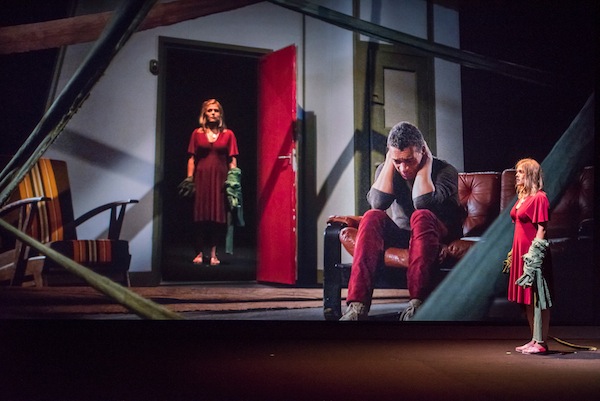“Blank Out” reenvisions opera with 3D film, video, electronics at Park Avenue Armory

Miah Persson and Roderick Williams in Michel van der Aa’s “Blank Out” at the Park Avenue Armory. Photo: Stephanie Berger
Blank Out, the multimedia piece for soprano and 3D film by Michel van der Aa that had its U.S. premiere Thursday night at the Park Avenue Armory, opened with a single spotlight on an old Ampex-type reel-to-reel tape deck.
Uh-huh. An opera about memory.
A little later, after a description of a child’s death by drowning, a woman was seen slowly assembling a model of a house.
Putting the pieces back together. Got it.
But if his symbols were on the obvious side, the composer/visual artist’s handling of them was anything but. In a moderate-sized theater space carved out of the Armory’s vast Wade Thompson Drill Hall, van der Aa created a kind of sonata form of visual themes using live stage action, live video, recorded video, and eventually eye-boggling combinations of all three.
He was careful, however, not to let the gee-whiz technical effects become the point of the show, but to introduce them gradually, so as to serve his elegiac text. The three-dimensionality of his film was barely perceptible at first, but by the show’s next-to-last scene a cloud of dead leaves seemed to swirl off the screen into the stage space, and a rockslide seemed headed straight at the viewer.
The Dutch composer was similarly deft on the musical side, assembling expressive vocal lines for soprano Miah Persson onstage and baritone Roderick Williams on film, and eventually combining the two singers over a recorded choir and synthesizer. If the result was less memorable than the visuals, it was because the emphasis was less on vocal display than on sensitive declamation of some rather elusive texts by the South African poet Ingrid Jonker (translated from Afrikaans into English by André Brink and Antjie Krog).
For that reason, and because what little plot this “chamber opera” had was narrated by the singers, not enacted onstage, Blank Out often resembled a lieder recital with visuals more than an opera.
Another distancing factor for opera traditionalists was that the music was conveyed 100% electronically—including the voice of Persson onstage, which was amplified and subtly processed to mesh with the rest of the musical texture.
It all added up to a Gesamtkünstler role for Michel van der Aa that Richard Wagner might have envied: composer, librettist, filmmaker, stage director, and even, with his synthesizer, provider of the “orchestra.” (The British director Sophie Motley was credited as “dramaturg,” an advisory role.)
The kernel of inspiration for van der Aa’s meditation on grief and memory came from the life and work of Jonker, who is sometimes called the South African Sylvia Plath. While the comparison does justice to neither writer, the poignancy of Jonker’s poetry and her life story—full of bravery but even fuller of heartaches, ending early in suicide–make it inevitable.
To create the libretto, van der Aa wove Jonker’s poetry into a narrative of a drowning involving a mother and son. (Jonker herself died in 1965 by walking into the sea and drowning.) Exactly who drowned—the boy or the mother who tried to save him—was left unclear for much of the piece, as van der Aa explored both the vividness and the unreliability of memory. (Hence, perhaps, the opera’s title, with its echoes of Hitchcock and Antonioni, who dealt with similar themes in their films.)
Happy memories of family life were spoken by the singers warmly but matter-of-factly, as if they were being interviewed for a documentary. Inevitably, however, the emotional undercurrents of loss spurred them into music.
As the young mother and the son grown to (imaginary?) adulthood, singers Persson and Williams inhabited their separate worlds, but eventually interacted with each other, even briefly danced together, across a divide between reality and illusion, the physically possible and impossible, the real and the surreal, the palpable and tricks of the light.
In a role that developed in stages from fragmentary near-silence to extreme, jabbering agitation, soprano Persson sang her increasingly disjunct vocal lines with sparkling clarity and sensitivity to the text. She also doubled as video operator, training a camera closely on her house model to simulate vast interiors onscreen.
In a calmer, retrospective role, filmed walking through a life-size house, Williams as the adult son expressed the tug of memory in a taxing high baritone tessitura, yet managed to give his singing an intimate, conversational feeling.
On the film’s soundtrack, the Netherlands Chamber Choir, conducted by Klaas Stok, produced a pure, Palestrina-like sound that blended nicely with another kind of “early music,” the stringy, flute-y, instrument-imitating sonorities of analog synthesizers of the 1980s, now being imitated in their turn by the digital electronics of today.
Completing perhaps the shortest credit list of any opera production, lighting designer Floriaan Ganzevoort successfully navigated around the set’s large video screen to highlight moments of stage action for direct viewing and also for live and video meshing with the film, a complex task.
Following the piece’s thudding, fortissimo climax, with visuals surging together to evoke the violence that time does to life and memory, Williams was left with one last quiet monologue in the house’s attic before the film faded to black. Soprano Persson was joined onstage by Williams’s onscreen image and by the “onlie begetter” himself, Michel van der Aa, to acknowledge the audience’s thoughtful, appreciative applause.
Blank Out will be repeated 8 p.m. Friday, Monday and Wednesday, and 3 p.m. Sunday. armoryonpark.org; 212-933-5812.


